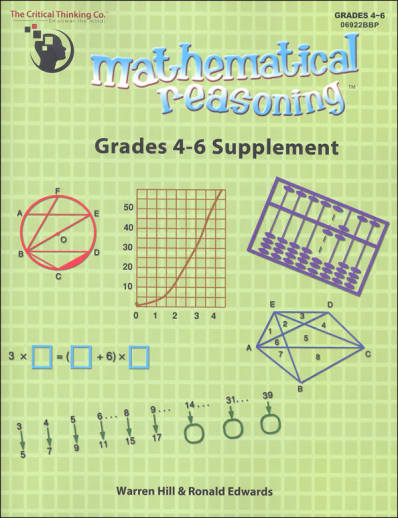Deepening and developing mathematical literacy takes time and practice! This supplemental workbook for grades 4-6 offers plenty of practice with math concepts. The goal is for students to be proficient and fluent in Numbers and Numerations, Geometry, Operations, Measurement, Relations, as well as Tables and Graphs. Great to add alongside the Mathematical Reasoning Program or to supplement any other math program for more practice. Extra practice with math concepts allows for a strong mathematical foundation to equip students to apply the skills when needed. Answers are in the back of the book and provide a great self-check option. A brief “Role of the Teacher” section is provided at the beginning to help facilitate your role in this student-independent workbook. Pages are perforated for easy removal. 320 pgs, pb. ~Rebecca
Mathematical Reasoning Supplement - Grades 4-6
Product Overview
- Math resource containing over 1,300 individual practice exercises!
- Open-and-go math worksheets make a great practice supplement to any math curriculum
- A great way to introduce logic, analytical, numerical, and critical thinking skills
Description
If you're searching for additional practice pages to supplement your math program, but are wanting more than basic drills, then this is the series you've been looking for. These supplement books contain page after page of non-routine math problems that will challenge your child's grasp of math concepts as well as ability to mathematically reason.
The following is a small sampling of problems you can expect from this series. For example, in the Grades 2-4 supplement, your child is tasked with forming the largest/smallest sum, difference, and product by choosing operands from a given set of numbers. In Grades 4-6, your child is challenged to deduce possible values for an unknown value N given a set of 4-5 rules, or number properties. And finally, in the Middle School Supplement, your child's understanding of percentage is put to the test by calculating the percentage of a pizza's surface area that is covered in pepperoni.
The lower and upper elementary supplements (2-6) each contain over 300 pages, with practice divided into 6 key content areas: Number and Numeration, Geometry, Operations, Measurement, Relations, and Tables and Graphs. The middle school supplement (7-9) is over 300 pages, with practice divided into 12 content areas: 2D Geometry, Number Operations; Rates, Ratios and Proportions; Probability, Fractions, Patterns, Percents, Graphing, Statistics, Number Theory, 3D Geometry, and Miscellaneous. All supplement books contain reproducible student pages with answer guide included. ~ Anh
| Product Format: | Paperback Book |
|---|---|
| Grades: | 4-6 |
| Brand: | Critical Thinking Company |
| ISBN: | 9781601444158 |
| Length in Inches: | 11 |
| Width in Inches: | 8.5 |
| Height in Inches: | 0.75 |
| Weight in Pounds: | 2.35 |

